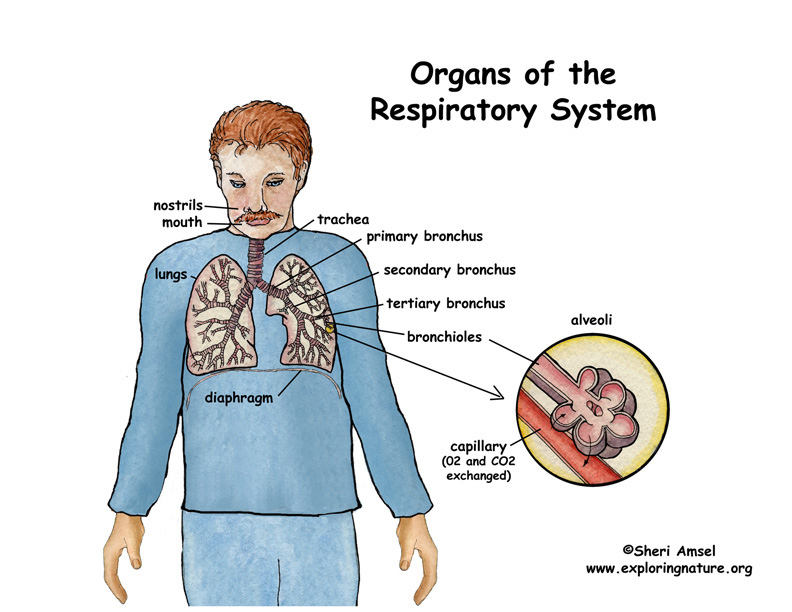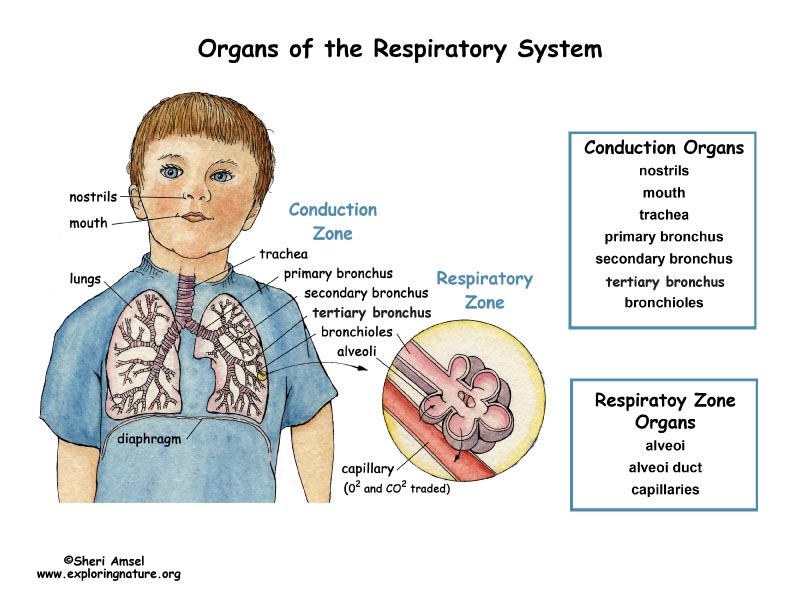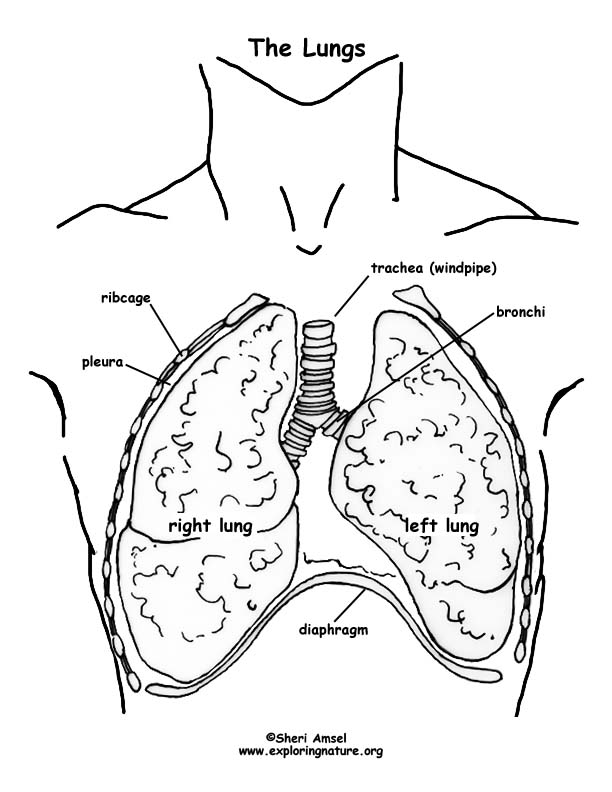

Every cell in the body must have oxygen at all times to survive. They also must get rid of their carbon dioxide waste. That is the job of the respiratory system.
There are actually four parts to respiration.
The organs of the respiratory system include: nose, pharynx, larynx, trachea, bronchi, bronchioles, lungs and alveoli.
We can break the organs of the respiratory system down into two parts:
The respiratory zone, where the actual gas exchange happens. This includes: the alveoli, their tiny ducts and some of the smaller bronchioles.
The rest of the organs are simply conducting zone (dead air space). This includes: nose, pharynx, larynx, trachea, and bronchi.
The Breathing Pathway
The nose is the only part of the respiratory system that you can see. It is where air enters but it is also where air is warmed, made moist, filtered, cleaned, and smelled.
Next it passes through the pharynx, which is just a passageway, but it is ringed by tonsils that trap and kill bacteria that enter with the air.
The larynx is a doorway. When food is passing through the pharynx, the larynx closes. When we inhale air, it is open and passes through toward the lungs. The larynx also has the vocal cords that make sound for speech. After air passes through the larynx, they enter the trachea.
The trachea or windpipe is about 4 inches long (12 cm) and is kept open by tiny rings of stiff cartilage. The last ring of cartilage is called the carina and is covered by sensitive tissue. If you inhale anything but air, when it touches the carina, you cough violently until it is gone. This protects the lower airways from being blocked.
The trachea splits at the bottom to become the two bronchi, one for each lung. The right and left bronchi enter the lungs and branch many times into smaller and smaller airways.
Until now the air has just passed through the conductive zone. No gas exchange has occurred. Now it enters the respiratory zone from the bronchioles down to the tiny alveoli.
True respiration begins in the smallest bronchioles - the respiratory bronchioles. They branch into alveolar ducts and finally into the tiny alveoli. They look like tiny bunches of grapes. This is where gas exchange occurs.
The capillaries that carry oxygen lie right up against the alveoli and form the respiratory membrane. Across this membrane, when the oxygen is traded for carbon dioxide, respiration has occurred.
The two lungs fill the ribcage around the heart and the large blood vessels that flow to and from the heart. The heart is tilted a bit to the left so the left lung is smaller than the right lung. The left lung has two lobes (sections). The right lung has three lobes (sections).
Inside each lobe, there are smaller segments that each have their own blood supply bringing carbon dioxide in and oxygen out.
The pulmonary arteries bring the carbon dioxide into the lungs and the pulmonary veins bring the oxygen out and back toward the heart. This is the only place in the whole body where veins carry oxygen-rich blood and arteries carry oxygen-poor blood.
The bronchial tree with all its branching ducts down to the smallest alveoli are found throughout the lung segments.
The lungs are covered by a two-layer membrane called the pleura. These two layers have a slippery fluid between them that allows them slide by each other when you inhale and exhale. The lungs are very stretchy (elastic). When you inhale they expand. When you exhale they spring back into shape. With each inhale and exhale we have exchanged life giving oxygen for the carbon dioxide waste that we need to be rid of.
The big, dome-shaped diaphragm muscle is attached to the base of the lungs and is anchored to the ribcage. It helps with lung expansion during breathing. Smaller intercostals muscles between the ribs help with the expansion and compression of the ribcage during breathing.
__________________________________________________________________________________
TESTING
Assess Respiratory System comprehension with the Mutiple Choice Test.
Study the Respiratory System Diagram, then test your knowledge with the Respiratory System Labeling.
__________________________________________________________________________
When you research information you must cite the reference. Citing for websites is different from citing from books, magazines and periodicals. The style of citing shown here is from the MLA Style Citations (Modern Language Association).
When citing a WEBSITE the general format is as follows.
Author Last Name, First Name(s). "Title: Subtitle of Part of Web Page, if appropriate." Title: Subtitle: Section of Page if appropriate. Sponsoring/Publishing Agency, If Given. Additional significant descriptive information. Date of Electronic Publication or other Date, such as Last Updated. Day Month Year of access < URL >.
Amsel, Sheri. "Respiratory System Overview" Exploring Nature Educational Resource ©2005-2024. December 13, 2024
< http://exploringnature.org/db/view/1054 >


